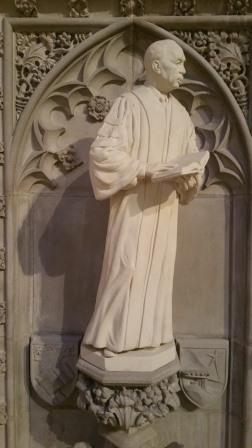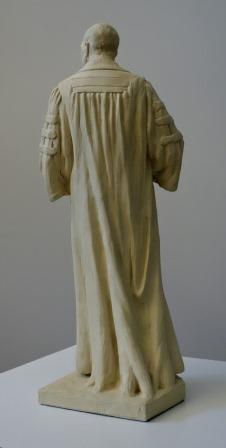Thursday, March 10, 2016 5:57 PM

 In 2009, Washington National Cathedral completed the carving and installation of three limestone statues located above the sedilia[1]. The statues depict three people who were chosen for this honor because of the extraordinary manner in which their lives personified Christian virtues. The three are John Donne, a 17th-century English poet and cleric in the Church of England; George Herbert, who also was a 17th-century English poet, orator and Anglican priest; and Howard Thurman, a 20th-century African-American author, philosopher, theologian, educator and civil rights leader.
In 2009, Washington National Cathedral completed the carving and installation of three limestone statues located above the sedilia[1]. The statues depict three people who were chosen for this honor because of the extraordinary manner in which their lives personified Christian virtues. The three are John Donne, a 17th-century English poet and cleric in the Church of England; George Herbert, who also was a 17th-century English poet, orator and Anglican priest; and Howard Thurman, a 20th-century African-American author, philosopher, theologian, educator and civil rights leader.
The statues were designed by Chas Fagan, a gifted American sculptor, who not only renders his subjects in incredibly realistic fashion, but also incorporates thoughtful symbolism into his designs that captures some compelling aspects of the person’s life.
For example, Mr. Fagan depicted Howard Thurman in his preaching robes to convey his commanding presence as a preacher and orator. Dr. Thurman is standing, leaning forward in earnest on the balls of his feet toward the congregation, as though conveying an urgent message of great importance. In researching the life of Dr. Thurman, Mr. Fagan learned that a mighty oak tree was an important symbol to Dr. Thurman, a manifestation of God’s strong and enduring presence over the course of his life. Thus, Mr. Fagan designed the lower portion of Dr. Thurman’s robes to appear like the base of an oak tree, with its muscular roots extending deep into the earth below.
When the time arrived to consecrate the statues, the National Cathedral was fortunate that a number of Dr. Thurman’s family and friends were able to attend and take part in the service. However, the stone brackets on which the statues permanently sit are positioned more than ten feet above the sanctuary floor. Hence, people are unable to fully see and appreciate some of the statues’ finer details. After the consecration, since the family was unable to see and enjoy the fine details of the statue, I invited them to my office for a face-to-face encounter with the full-size plaster model that guided the carving of the stone statue. Immediately upon seeing the plaster model, the family reacted as if Dr. Thurman had returned from the dead for a visit! Joy beamed from their faces as they approached the piece and looked closely into his eyes. They gently stroked his head and patted his back. They posed for multiple photos and lingered to reminisce over fond memories of Dr. Thurman. There seemed to be a reluctance to leave, as if doing so would break the sacredness of the moment. Truly, it was a moving family reunion of sorts.
 As Cathedral Conservator, I was fortunate to participate in each distinct phase of this artistic project—from conceptualization, to design, fabrication, installation and ultimately, appreciation. What I observed is that inherent in the process of any “successful” artistic project (and by “successful,” I mean that the final work of art serves to enrich and inspire the recipient—not necessarily all recipients, but a significant number) is the mysterious transference of spiritual enthusiasm from subject matter through the artist to the recipient, with each participant in this process having a significant role to play.
As Cathedral Conservator, I was fortunate to participate in each distinct phase of this artistic project—from conceptualization, to design, fabrication, installation and ultimately, appreciation. What I observed is that inherent in the process of any “successful” artistic project (and by “successful,” I mean that the final work of art serves to enrich and inspire the recipient—not necessarily all recipients, but a significant number) is the mysterious transference of spiritual enthusiasm from subject matter through the artist to the recipient, with each participant in this process having a significant role to play.
First of all, the subject matter, be it one or more individuals or a specific event, must have a compelling story to tell—a story that transformed the world in a positive fashion at a historic place in time, while also having the capacity to continue doing so as long as the story is conveyed in an effective manner.
The artist then must discern the essential characteristics of the subject matter and devise an artistic expression that conveys the characteristics to the recipient with clarity, strength and inspiration. In theological terms, the artist conceives a method to incarnate the passions of the subject matter and through creative skill, make them tangible to others observing the work in the present moment.
Finally, the recipient must be a willing participant in the process and not simply a passive consumer. He or she must exert an effort to understand the subject matter and appreciate the work of art to enjoy the benefits. And the benefits can be enormous!
Imagine transcending the limits of time and space to experience life in an earlier age, then to realize the similarities we share in the present age with those in the past. Historic figures come to life; the passions that inspired them can come alive in us, enriching not only our personal existence, but the manner in which we continue to live and interact with others. Truly, good art is more than simply an inanimate object. It has the power and potential to be a transformative, life-giving experience.
[1] Sedilia is the traditional name for a grouping of three seats built into the thickness of the south wall of the sanctuary, adjacent to the high altar. The seats are intended for the clergy who are leading worship.
[Read the rest of this article...]